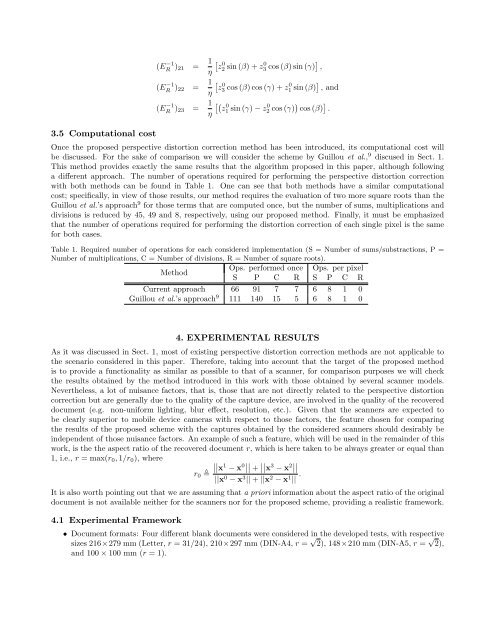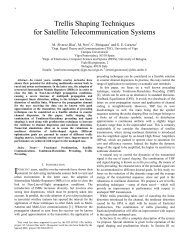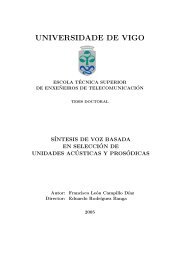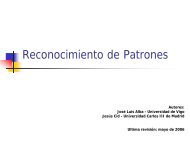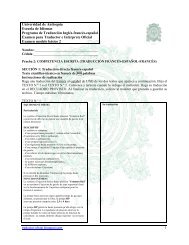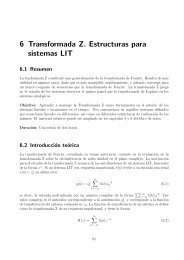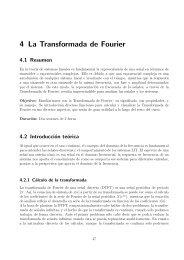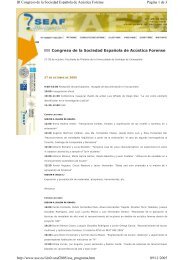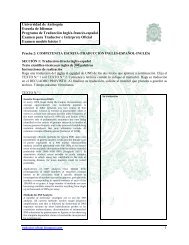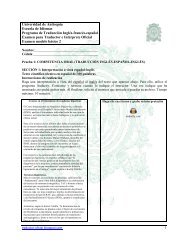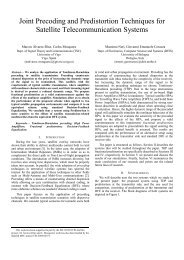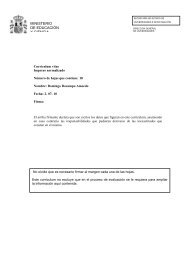A new method for perspective correction of document images
A new method for perspective correction of document images
A new method for perspective correction of document images
- No tags were found...
You also want an ePaper? Increase the reach of your titles
YUMPU automatically turns print PDFs into web optimized ePapers that Google loves.
(E −1R ) 21 = 1 [z0η 2 sin(β) + z3 0 cos (β) sin (γ) ] ,(E −1R ) 22 = 1 [z0η 3 cos (β) cos (γ) + z1 0 sin (β) ] , and(E −1R ) 23 = 1 [(z0η 1 sin (γ) − z2 0 cos (γ) ) cos (β) ] .3.5 Computational costOnce the proposed <strong>perspective</strong> distortion <strong>correction</strong> <strong>method</strong> has been introduced, its computational cost willbe discussed. For the sake <strong>of</strong> comparison we will consider the scheme by Guillou et al., 9 discused in Sect. 1.This <strong>method</strong> provides exactly the same results that the algorithm proposed in this paper, although followinga different approach. The number <strong>of</strong> operations required <strong>for</strong> per<strong>for</strong>ming the <strong>perspective</strong> distortion <strong>correction</strong>with both <strong>method</strong>s can be found in Table 1. One can see that both <strong>method</strong>s have a similar computationalcost; specifically, in view <strong>of</strong> those results, our <strong>method</strong> requires the evaluation <strong>of</strong> two more square roots than theGuillou et al.’s approach 9 <strong>for</strong> those terms that are computed once, but the number <strong>of</strong> sums, multiplications anddivisions is reduced by 45, 49 and 8, respectively, using our proposed <strong>method</strong>. Finally, it must be emphasizedthat the number <strong>of</strong> operations required <strong>for</strong> per<strong>for</strong>ming the distortion <strong>correction</strong> <strong>of</strong> each single pixel is the same<strong>for</strong> both cases.Table 1. Required number <strong>of</strong> operations <strong>for</strong> each considered implementation (S = Number <strong>of</strong> sums/substractions, P =Number <strong>of</strong> multiplications, C = Number <strong>of</strong> divisions, R = Number <strong>of</strong> square roots).MethodOps. per<strong>for</strong>med once Ops. per pixelS P C R S P C RCurrent approach 66 91 7 7 6 8 1 0Guillou et al.’s approach 9 111 140 15 5 6 8 1 04. EXPERIMENTAL RESULTSAs it was discussed in Sect. 1, most <strong>of</strong> existing <strong>perspective</strong> distortion <strong>correction</strong> <strong>method</strong>s are not applicable tothe scenario considered in this paper. There<strong>for</strong>e, taking into account that the target <strong>of</strong> the proposed <strong>method</strong>is to provide a functionality as similar as possible to that <strong>of</strong> a scanner, <strong>for</strong> comparison purposes we will checkthe results obtained by the <strong>method</strong> introduced in this work with those obtained by several scanner models.Nevertheless, a lot <strong>of</strong> nuisance factors, that is, those that are not directly related to the <strong>perspective</strong> distortion<strong>correction</strong> but are generally due to the quality <strong>of</strong> the capture device, are involved in the quality <strong>of</strong> the recovered<strong>document</strong> (e.g. non-uni<strong>for</strong>m lighting, blur effect, resolution, etc.). Given that the scanners are expected tobe clearly superior to mobile device cameras with respect to those factors, the feature chosen <strong>for</strong> comparingthe results <strong>of</strong> the proposed scheme with the captures obtained by the considered scanners should desirably beindependent <strong>of</strong> those nuisance factors. An example <strong>of</strong> such a feature, which will be used in the remainder <strong>of</strong> thiswork, is the the aspect ratio <strong>of</strong> the recovered <strong>document</strong> r, which is here taken to be always greater or equal than1, i.e., r = max(r 0 ,1/r 0 ), where∣ ∣ x 1 − x 0∣ ∣ ∣ ∣∣ + ∣x 3 − x 2∣ ∣ ∣ r 0 ||x 0 − x 3 || + ||x 2 − x 1 || .It is also worth pointing out that we are assuming that a priori in<strong>for</strong>mation about the aspect ratio <strong>of</strong> the original<strong>document</strong> is not available neither <strong>for</strong> the scanners nor <strong>for</strong> the proposed scheme, providing a realistic framework.4.1 Experimental Framework• Document <strong>for</strong>mats: Four different blank <strong>document</strong>s were considered in the developed tests, with respectivesizes 216×279 mm (Letter, r = 31/24), 210×297 mm (DIN-A4, r = √ 2), 148×210 mm (DIN-A5, r = √ 2),and 100 × 100 mm (r = 1).


